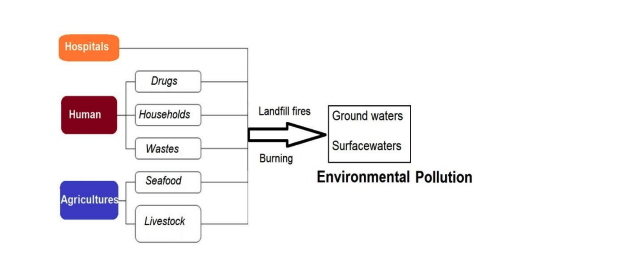
This study demonstrated the effects of initial concentration, solution pH value, adsorbent dosage, agitation time, and adsorption temperature on the Oxacillin (OCL) adsorption tests using cross-liked nanomaterial CuO/Graphene oxide/NH2 (CGN). The surface, well-dispersed in water has been studied by several research groups as an adsorbent to remove pollutant compounds from water environment. This article has an essential advantages to enhance the wastewater quality, especially hospital wastewater containing antibiotics, virus and bacteria.
The pharmaceutical antibiotics route released to the natural environment was very emergent now. The three major influents of antibiotics sources such as wastewater hospital, human wastes, and agricultural activities. It could be extensively and effectively used in human and pharmaceutical industry, aquaculture, seafood, and livestock. Investigating the effect of solution pH values on the OCL removal using CGN material. The data showed that there is not much difference in adsorption efficiencies at the wide neutral pH range from 5.0 to 9.0. It was suggested that the chemical mechanism such as electrostatic interactions did not strongly affect to the OCL removal by CGN. It could be concluded that the OCL adsorption efficiency of CGN reached above 96 % after 60 min. This method has removed antibiotic residues in the solution, and prevented the release of antibiotics that affect the environment. Because of the time limitation and effects of amid Covid-19 pandemics, this project was lack of several future activities and plans such as modification material with other chemical agents, removal carcinogen metals.
Authors:Hoang Cao Quyet1 , Nguyen Quang Thai1 , Vu Thi Mai Anh2,*, Pham Ky Anh3 , Ju Hyung Lee4 1 Kinh Mon High School, Kinh Mon, Hai Duong city, Vietnam 2 Ha Long High School for Gifted Students, Ha Long city, Quang Ninh province, Vietnam 3 3 Department of Agriculture and Rural Development of Quang Ninh, Ha Long city, Quang Ninh province, Viet Nam 4 Engineering, Science and Technology, Kongju National University, Donggwang-ro 3-gil, Seocho-gu, Seoul, Korea * Corresponding author: Teacher Vu Thi Mai Anh (E-mail: vuthimaianh.c3chl@quangninh.edu.vn)